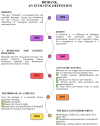Glioblastoma: Overview of Proteomic Investigations and Biobank Approaches for the Development of a Multidisciplinary Translational Network
- PMID: 40647449
- PMCID: PMC12248909
- DOI: 10.3390/cancers17132151
Glioblastoma: Overview of Proteomic Investigations and Biobank Approaches for the Development of a Multidisciplinary Translational Network
Abstract
Glioblastoma is a highly aggressive, infiltrative brain tumor of the central nervous system (CNS). Its extensive molecular and biochemical heterogenicity hinders the identification of reliable biomarkers and therapeutic targets, thereby making prognosis and existing therapy ineffective. In recent years, breakthroughs in the use of proteomics on a range of biological samples, such as plasma, cerebrospinal fluid (CSF), tissues, brain cells, and exosomes, represent a potential improvement to GBM investigations. Mass spectrometry-based approaches represent an important technique in the characterization of the tumoral proteome, for the identification of differentially expressed proteins, and for studying altered molecular pathways involved in tumor stages. Proteomics studies advance our knowledge about GBM pathogenesis, the discovery of reliable diagnostic and prognostic markers, and therapeutic approaches, also. In this context, for the effective application of proteomics on GBM, it is mandatory to develop a translational network by integrating hospitals, biobanks, and research institutions into a single network, to enable a collaborative approach across disciplines, thereby enabling rapid translation to clinical application of new proteomic insights. Today, high-quality biobanks play a key role in enabling collaborative, ethically compliant research, supporting the effective application of proteomics in glioblastoma studies and the translation of discoveries into clinical practice. This review explores current trends in proteomics and GBM research, highlighting how leveraging biobank infrastructure and fostering institutional cooperation can drive the development of targeted pilot projects to enhance the impact and effectiveness of glioblastoma research.
Keywords: biobanks; biomarkers; brain tumors; clinical translation; glioblastoma; glioma; mass spectrometry; proteomics; translational network; tumor microenvironment.
Conflict of interest statement
The authors declare no conflicts of interest.
Figures






References
-
- Louis D.N., Perry A., Wesseling P., Brat D.J., Cree I.A., Figarella-Branger D., Hawkins C., Ng H.K., Pfister S.M., Reifenberger G., et al. The 2021 WHO Classification of Tumors of the Central Nervous System: A Summary. Neuro-Oncology. 2021;23:1231–1251. doi: 10.1093/neuonc/noab106. - DOI - PMC - PubMed
Publication types
Grants and funding
LinkOut - more resources
Full Text Sources

